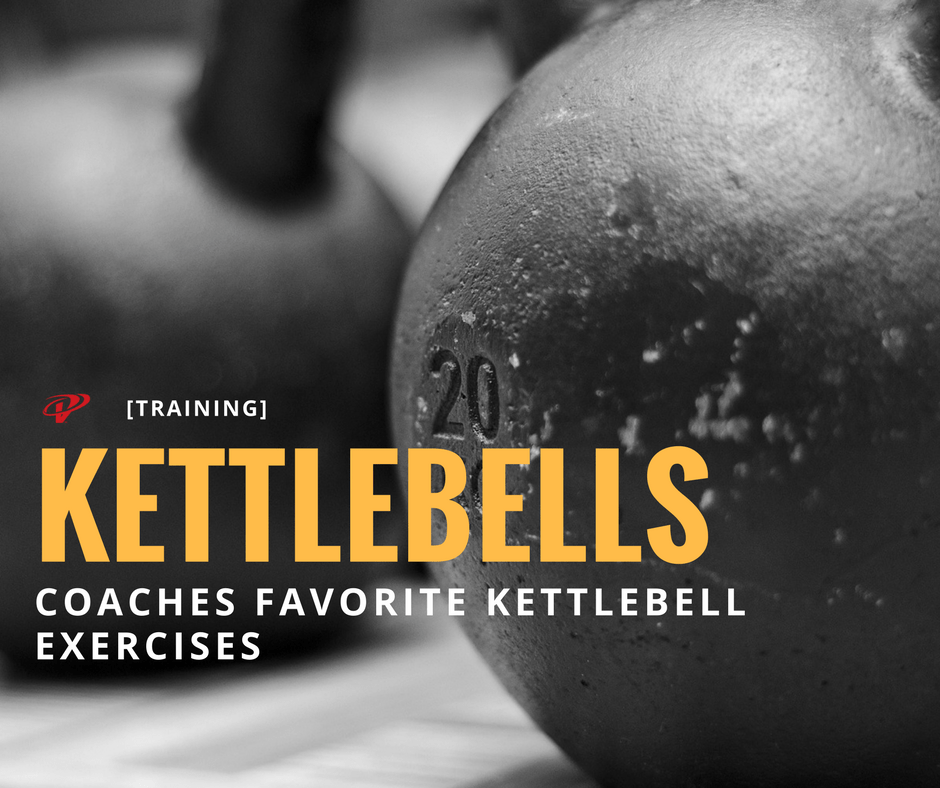Kettlebells are a great tool which have been around for decades but have become popular again. And it’s for good reason; they’re versatile and dynamic. We surveyed some of our coaches to find out what their favorite exercises are with a kettlebell.
Coach Mike’s Pick: Double Kettlebell Clean + Squat + Push Press
The Double Kettlebell Clean+Squat+Push-Press is a full-body exercise complex that gives you a lot of bang for your buck. When done correctly, you develop power through the Clean, leg strength in the Squat, vertical pressing strength in the Push Press, and core strength throughout the entire movement.
Execution: Before beginning, you must keep your core rigid through the entire movement to ensure you don’t hurt yourself.
- Start with the two kettlebells of the same weight 1-2 feet in front of you and feet slightly wider than your shoulders.
- With knees slightly bent, keep your back flat and push your hips back to the wall behind you and grab the kettlebells tightly.
- Take a good breath and “hike” the kettlebells backward between your legs
- Stand up as fast you can to snap the kettlebells up and forward into the rack position.
- Clean the kettlebells to the rack position.
- Take a new breath, slowly squat down with the kettlebells as low as you can then drive up as fast as possible.
- Start to press the kettlebells above your head as you reach the top position, using the momentum of your squat to help finish the movement.
- Once the kettlebells are straight above your head, take another good breath and slowly pull the kettlebells down to the Rack position.
- Once in the rack position, reset with a good breath and prepare yourself for another repetition. Instead of starting with kettlebells on the ground, carefully let the kettlebells “fall” (while still holding them) and again hike them back through your legs and repeat the exercise for as many reps as prescribed.
Velocity Sports Performance on Vimeo.
If your goal is to develop all-around strength, use a heavy set of kettlebells for 3-6 reps. If your goal is to get a solid metabolic workout, go with a lighter set with which you can get in 8+ challenging reps.
Misao’s Pick: Halo
The Kettlebell Halo improves upper body mobility and stability. It is an overhead pattern that requires core stability as well as mobility and stability of the shoulders and shoulder blades.
Execution:
- In a kneeling or standing position, hold the kettlebell with both hands by the horns
- Brace your core and hold the bell in front of your chest.
- Slowly circle the bell around your head clockwise, then counter-clockwise. The movement must be slow and under control.
- The weight of the bell needs to be light enough so your torso does not sway side to side or arch.
Velocity Sports Performance on Vimeo.
You can easily progress this exercise by changing the way you hold the bell. Holding the weight with the bell pointing down is easier as the weight stays securely in your palms. If you grip it upside down (with the bell on top) it becomes more challenging because the weight travels farther away from your body, increasing the strain on the muscle due to a longer lever.
Coach Kenny’s Pick: Turkish Get Up
The Turkish Get-Up is great for shoulder stability, overall strength, and just plain toughness. It also can help develop a sense of body control and awareness and test an athlete’s focus.
Execution:
- Start laying on your back with your right knee bent and your left arm extended out to the side. Your kettlebell should be on the ground next to your right arm.
- Grasp the bell with your right hand and press it up so your right arm is completely straight and perpendicular to the ground.
- Keep your eyes on the bell throughout the entire movement.
- Roll up onto your left elbow, and then to your left hand.
- Push your hips up towards the ceiling as high as you can.
- Slide your left leg under your body and come up onto your left knee.
- Stand up.
To get back down, simply reverse the movement.
- Come down to your left knee.
- Place your left hand on the ground
- Slide your left leg out from underneath you so it’s totally straight, keeping your hips pressed up.
- Let your hips come to the ground.
- Lower on your left elbow.
- Completely lower yourself to the ground so you are laying flat.
- When bringing the kettlebell back to the ground, be sure to use your free hand to help guide it. Safety first.






Now do the same thing on the other side.
Coach Yo’s Pick: Bottom-Up Overhead Press
This series is great for shoulder stability, grip strength, elbow joint health, and core strength and stability based on athlete’s positioning. The Bottom-Up series gives the athlete a different stimulus since the load (kettlebell) is in an unstable position. This will improve overall proprioception (your level of awareness of where your body is in space), and by using different base positions ( ½ Kneeling, Tall Kneeling, Standing, Single Leg, etc), allows athletes to develop core strength and stability. It is a very unique exercise, and the kettlebell is an ideal tool for its execution.

Execution: Before you start, make sure that you have proper overhead mobility and stability and can do basic overhead press exercises with dumbbells or barbell. Once you have that skill, you can start by holding the kettlebell upside-down (bottom-up) right in front of shoulder. Make sure you the weight you use is not more than you can control with your grip alone. You can check holding the bell upside-down in a static position for a while without letting it drop. Ensuring you have basic stability before adding movement is always a good idea and will prevent needless injuries.
Performing the exercise in different positions will work on different elements of core strength and stability.
Coach Gary’s Pick: Split Squat KB Complex
The Split Squat KB Complex addresses muscle activation patterning, neuromuscular control, and dynamic stability of the trunk and lower extremities. This complex will challenge any athlete while reducing the likelihood of lower extremities injuries. This is valuable because more than 50% of injuries in college and high school athletics are knee injuries according to the American College of Sports Medicine. This 4-phased complex also allows coaches to progress athletes based on ability, making it excellent for novices and experienced athletes alike.
Execution:
Starting position – Kneel with your right foot flat and the right knee directly over the heel. Start with the bell on the ground in front of your left knee.
Starting Movement:
Inhale and lift the kettlebell with your left hand to the level of your forward (right) thigh.
Level your hips by pressing the hips forward and Press the forward (right) heel into the ground.
The upper body should remain tall and erect with the chest up and out and the shoulders level and stacked over the hips.
Phase 1: Split Squat – Stand up on both legs while driving your front heel into the ground. Once your legs are fully extended, reverse the motion and lower the body back to the starting.
Phase 2: Clean to Split Squat – Quickly thrust the body upward and bring the bell to the front of your shoulder. With the bell in this position, extended both legs to stand up, again driving your front heel into the ground. Once fully extended reverse the motion and lower the body back to the starting position.
Phase 3: Jerk to OH Split Squat – Quickly thrust the body upward and Jerk the bell overhead with the upper arm tight to the ear. With the bell in this position extended both legs to elevating the body upper, think about driving your front heel into the ground. Once fully extended reverse the motion and lower the body back to the starting position but remaining on the feet.
Phase 4: OH Split Squat to knee drive – With bell overhead and the upper arm tight to the ear, extend both legs to stand up. Once fully extended, quickly drive the back knee up and in front of body then back to the same spot on the ground. Once ground contact is made lower the body back to the starting position but remaining on the feet.
Exercise 6: Pistol Squat
The Pistol Squat is a great way to test balance and overall hip and glute strength. It also gives you a clear interpretation of your strength to bodyweight ratio. If you can easily perform the movement as a bodyweight exercise, add a kettlebell.
Execution:
- Front rack the kettlebell of your choice. Hold the bell with whichever hand is opposite from your “down” leg.
- Load your weight over one leg and slowly lower yourself to the ground on a single leg.
- Extend your “up” leg in front of your and keep it from touching the ground.
- Load your bodyweight onto one leg and as you drop down into a squat shift the loading glute back and extend the opposite leg forward in an attempt to keep it from touching the ground.
If you want to challenge yourself further, try performing the same movement while standing on some type of balance pad to give your foot an unstable surface to manage.
Coach Rob’s Pick: Single Arm Kettlebell Swing
The Swing is certainly the most ubiquitous use of the kettlebell. Once you have mastered it, try moving onto the single arm swing. This variation adds an anti-rotational component to the explosive hip drive inherent to the Swing.
Execution:
- Start with your feet hip-width or slightly wider. The kettlebell should be on the ground about a foot in front of you. Remember that during any weightlifting exercise, it is crucial that you keep your core tight and your back flat. Failure to do so, especially during a ballistic movement like a kettlebell swing is asking for injury.
- The weight you select should be lighter than you think you need until you get the feel for the exercise.
- Drop your butt towards to floor while keeping your chest up, grasp the bell firmly with one hand and “hike” it behind you, keeping your wrist tight to your body.
- Stand up quickly and let the bell rise up to about shoulder height. This part of the movement should be snappy and crisp.
- Keep your grip on the bell and let it fall, swinging back behind you while you keep it tight to your body.
- Repeat this movement for as many reps as prescribed.
Once you have this movement down, you can challenge yourself by switching hands every rep. To achieve this, let the bell swing up to its highest point, at which time it should be weightless for a brief moment. Have your opposite hand ready to grab the handle as soon as you let go with the swinging hand.
Whether you alternate hands or not, the Single Arm Swing is sure to get your heart rate up, make you sweat, and develop leg strength and core stability. Have fun!
Velocity Sports Performance on Vimeo.



